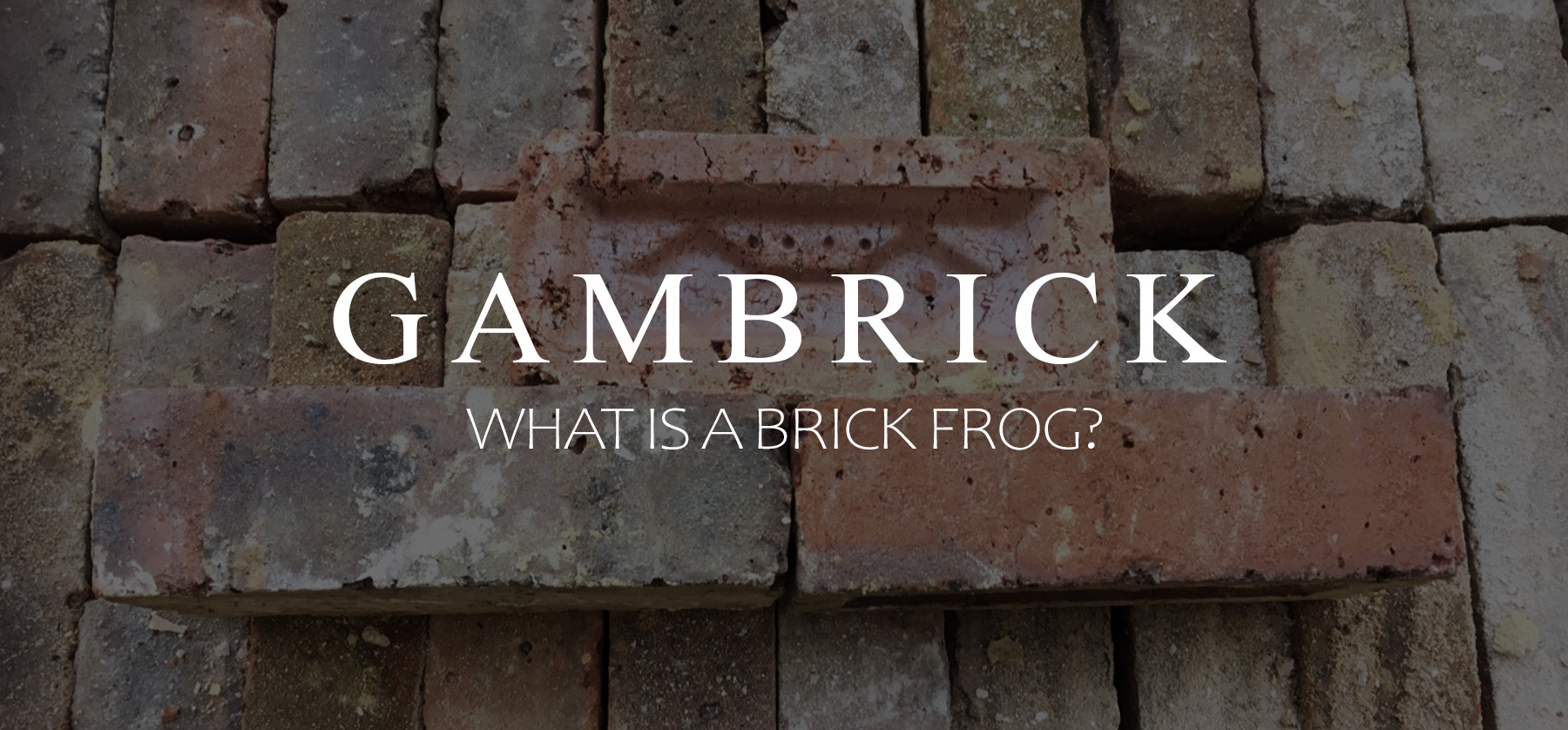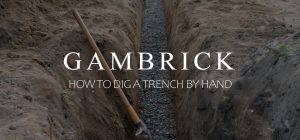What Is A Brick Frog?
A brick frog is a depression in one side, a.k.a. face, of a molded or pressed brick. If you pick up a brick with a frog, one side will be flat and the other will have a cavity built into it. The frog reduces the amount of material needed to produce the brick, reduces the weight of the brick making it easier to remove from the form and may also help heat reach the center of the clay bricks inside the kiln. When brick’s with frogs are used to build a wall, the frogs are filled solid with mortar. This extra mortar sitting inside the brick increases the walls sheer strength.
Does the brick frog face up or down? Either way is fine, this decision is up to the mason. There’s no code that dictates whether or not a frog should face up or down. Some masons prefer to face them up so they can be sure they’re filled solid with mortar. However I face them down. Having a the flat side of the brick facing up makes it easier to build a level mortar bed for the next row of bricks. Either way you do it, make sure the frog is filled with mortar which creates a full mortar bedding. Leaving the frogs empty creates a shell-bedding which is much weaker. You don’t want empty voids in the middle of your brick wall.
If the frog is laid up, it can hold water, which can cause brick deterioration. The frog creates a small pool for water to collect. Water penetration is an issue with bricks which can result in freeze thaw damage. This is another reason I prefer laying the bricks frog down.
What’s The Depression In A Brick Called?
The depression in the side of a brick is called a frog.
The term “frog” stems from the dutch word “kicker”. It has nothing to do with the amphibian frog most people picture when they hear the word.
Traditional brick making used wooden boxes with a “kicker” in the middle that helped release the clay brick from the mold. The word “kicker” comes from the lowlands of Belgium and Holland and translates into the English word “Frog”. When English speaking people adopted brick making in this way, they translated the name and it stuck.
What’s The Purpose Of A Frog On A Brick?
Brick frogs serve a few purposes.
- The depressions makes it easier to release the clay brick from the wooden mold.
- They may make it easier for heat to penetrate the center of the brick and fire it.
- Frogs are filled solid with mortar which increases the walls sheer strength. The mortar inside the frog is tied into the mortar bed.
Brick Frog Specifications
ASTM specifications C 62 (building brick), C 216 (facing brick), and C 652 (hollow brick) all set limits on the size of brick frogs.
- Frogs can’t be closer than 3/4 inch to any edge of the brick.
- Frogs greater than 3/8 inch deep at any point are treated the same as brick cores.
- Depressions less than 3/8 inch deep don’t affect the net area of the brick.
Most frogs are 1-2cm deep.
Working With Brick Frogs
Which direction does a brick frog face, up or down. Some masons recommend laying them up so that they’re easier to fill. But I disagree. I always lay the brick frog facing down.
The reason some masons lay them up is to ensure they’re filled solid with mortar, but you can still do that when they face down. It’s not very hard to fill the bricks solid before laying them. In fact, I usually have a helper fill my brick frogs with mortar for me and I just lay the bricks.
When the brick frog faces up it creates a pool where water can set. All bricks collect water because they’re pores. proper drainage and drying is important for any brick wall. The freeze thaw cycle can be very bad for a brick wall. I reduce the risk of my bricks holding water by facing the frog down.
It’s also very important to build a perfectly level wall and mortar bed. This is easier for me to do when the flat side of the brick is facing up.
It’s also easier for me to adjust a brick when the flat side is up. Brick masons will tap the top of the brick in different spots with the handle of their trowel to adjust the brick. This is easier when the top of the brick is flat. You may want to tap the center of the brick, but if the frog is up this isn’t possible.
Brick frogs are lighter than standard bricks because the center has a void. This is actually reversed once you fill the depression solid with mortar, but it makes hauling bare bricks easier.
The frog makes bricks easier to grip. They act as a sort of handle for the brick.
Brick Frog Vs No Frog
If you’re building a new brick wall, do you have to use bricks with a frog. The answer is no, you can use bricks without a frog to build a wall. But there are some benefits to both bricks you should consider.
Frogs create a void inside the brick. If you don’t fill them with mortar this can be a problem. If you’re a novice brick layer or don;t want to do the extra work, just use a solid brick. You won;t have to worry about filling them up prior to install.
Brick frogs increase a walls sheer strength. They tie the center of the brick to the mortar bed. But in some cases this isn’t something you’ll need. Most brick walls built these days are not structural and get tied into the wall framing. In these cases you probably don’t need brick frogs.
I recommend using brick frogs when you need the extra strength. If the bricks are tied into a structural wall behind it then you probably don’t need them. However, if the wall is a structural brick wall without additional support, I’d use the frogs.
A wall built with brick frogs can be harder to repair. To replace a standard brick with two flat sides, you chisel out the mortar and wiggle the brick out. Often times, by removing just a small amount of mortar the brick breaks free. But brick frogs are harder. Because the mortar bed ties into the center of the brick, you generally have to chisel deep to free it.
Summary: What’s A Brick Frog?
A brick frog is a depression in one side, a.k.a. face, of a molded or pressed brick. If you pick up a brick with a frog, one side will be flat and the other will have a cavity built into it. The frog reduces the amount of material needed to produce the brick, reduces the weight of the brick making it easier to remove from the form and may also help heat reach the center of the clay bricks inside the kiln. When brick’s with frogs are used to build a wall, the frogs are filled solid with mortar. This extra mortar sitting inside the brick increases the walls sheer strength.
Does the brick frog face up or down? Either way is fine, this decision is up to the mason. There’s no code that dictates whether or not a frog should face up or down. Some masons prefer to face them up so they can be sure they’re filled solid with mortar. However I face them down. Having a the flat side of the brick facing up makes it easier to build a level mortar bed for the next row of bricks. Either way you do it, make sure the frog is filled with mortar which creates a full mortar bedding. Leaving the frogs empty creates a shell-bedding which is much weaker. You don’t want empty voids in the middle of your brick wall.
If the frog is laid up, it can hold water, which can cause brick deterioration. Water penetration is an issue with bricks which can result in freeze thaw damage. This is another reason I prefer laying the bricks frog down.
If you have any questions or comments about brick frogs, Email any time.




















